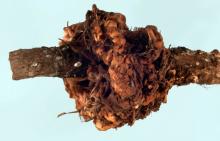See:
Fir, True (Abies spp.) - Heterobasidion Root Disease
Cause Heterobasidion occidentale, a fungus. This native soil pathogen is often in large old tree stumps. It can live several decades as a saprophyte on stumps and roots. Infection is mainly from airborne spores produced by conks on or in old stump hollows. Spores infect freshly cut stump surfaces or trunk wounds. Cut stumps are susceptible only for a short period of time. Infection spreads from stumps to roots of healthy seedlings or trees that contact infected wood. Root infections may lead to root and lower bole decay; the tree dies directly or as a result of windthrow. Trunk infections lead to stem decay. Bark beetles also often infest infected trees.
Host range of this fungus includes 150 conifer and angiosperm trees. The disease is especially troublesome on ponderosa and lodgepole pines in southern Oregon, often on drier sites, resulting in tree mortality. Other pines are rarely killed. Substantial forest openings where regeneration is dead or missing are often centered on large pine stumps. Urea in an aqueous solution of 20% or higher has been effective as a fresh stump protectant on pine.
Symptoms In the later stages of root infection, affected trees show crown yellowing and reduced terminal and lateral branch growth. These are general symptoms and can be confused with any other root rot problem. Infected roots may be covered by mycelium of the pathogen, but most often no mycelium or conks are present. Decayed wood may be laminated or stringy with black flecks. Seedlings can begin to die a few years after planting. Diseased trees may occur in pockets in the field.
Cultural control
- Monitor for staining in the older wood of recently cut trees that may indicate a problem in one or more fields.
- Remove and destroy infected trees and root systems if possible.
- In mixed-species areas, favor resistant species such as cedar or hardwoods when planting, thinning, or harvesting. Nordmann fir also has been found to be resistant.
- Avoid wounding tree roots and trunks.
- The use of dirt to cover freshly cut stumps has been suggested but has only worked in 2 of 3 tests.
Chemical control Treat freshly cut stumps with a surface protectant. This is important in plantations that do not yet show evidence of the disease.
- Treating grape pruning wounds with sealants or paints has been effective when used within 24 hours of a pruning cut and may be useful in this system as well. These products include B-Lock, Spur Shield, or Vitiseal. See labels for details.
- Cellu-Treat at 1 lb/gal water.
Biological control
- Phlebiopsis gigantea (formerly Peniophora gigantea) has been effective on pine and spruce but is not easily available.
- Trichoderma spp. have been tried with positive results on stumps of a few tree species and are readily available.
Reference Goheen, E.M., and Willhite, E.A. 2006. Field guide to the common diseases and insect pests of Oregon and Washington conifers. R6-NR-FID-PR-01-06. Portland, OR. USDA Forest Service, PNW Region.
Woodward, S., Stenlid, J., and Karjalainen, R., and Huttermann, A. 1998. Heterobasidium annosum: Biology, Ecology, Impact and Control. New York: CAB International.


